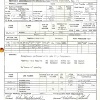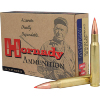When I talked to Accurate Arms, they told me AA2495 was a pressure curve duplicate of IMR 4895. And I can't tell much of a difference over a chronograph between the two.
As to the original specs. Understand there are those who want to prove the Garand is not weak, so they are going to promote magnum level reloading in the things. (and guess what, that person got their post in, before I got mine) Something else, what is in the TM's and specs is not reloading data. And what they were doing, at the powder makers, is different than what reloaders do.
First of all, for match ammunition, this was my standard in a Garand.
View attachment 1047914
If I kept my 168's and 175's around that velocity, the rifle shot well and I did not have malfunctions.
As for the 150's, all the US military ammunition I have fired, from the Garand days, was surprisingly mild. It is very possible that the ammunition was deliberately kept on the low end, because no one wanted malfunctions in combat.
This is very interesting, I got this with my lot of WC852
View attachment 1047915
The Quality Assurance specialist has cartridges calibrated to a Frankford Arsenal pressure barrel. He has the FA pressures and velocities, and he "corrects" the pressures and velocities in the vendor pressure barrel to the Frankford Arsenal numbers. He is getting pressures of 40 K, 41 K psia, velocities are actually below 2750 fps. And temperatures only approach 50 K when the powder is cooked to 125 F.
The original pressures and velocities were based on WW1 ammunition specifications and the pressures were a not to exceed. As powder technology advanced, the spec velocities could be met without powder pressures ever exceeding maximum pressures. I am going to claim, as time went on, both the Army Ammunition Arsenals and the Army rifle manufacturer's more or less adjusted their products in a symbiotic relationship. No one wanted malfunctions, and the extra work that would result from scandals.
I keep my 150 grain bullet at, or below 2700 fps for my Garands, M1903's, and M1917's.
However, civilian hot dogs want magnum level performances, and you will read all the time guys who are trying to make these things into magnums. Which then is why the CMP puts out these sort of warnings.
View attachment 1047916
if I were to buy factory ammunition for my Garand, I would look for something like this:
View attachment 1047917
made for a Garand gas system.
I would run away from any box like this
View attachment 1047918
If you want to be a hot dog, then just do it. I am not your advocate. You want to prove something about the strength of the Garand, have fun with your loads. I am not going to duplicate them, and I will ignore your advice.









